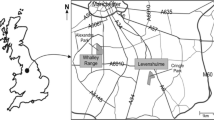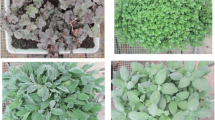Abstract
Aims
Green roofs are important novel urban ecosystems, but their shallow substrates can create plant water deficits in dry climates. Physiological approaches can improve green roof plant selection, and shrubs with high drought tolerance and conservative water use under water-deficit should perform well. The water potential at turgor loss point (Ψtlp) has been used to predict drought resistance. Therefore we aimed to determine whether Ψtlp could be used as a screening tool to assess drought resistance for green roof plant selection.
Methods
We evaluated 20 shrub species, originating from ecosystems varying in water availability, quantified by heat moisture index (HMI) and mean annual precipitation. We conducted a water-deficit experiment to measure Ψtlp, the degree of iso-anisohydry (△ΨMD) and water use (ET) in response to drought.
Results
Shrubs with lower Ψtlp were more anisohydric (greater △ΨMD) and had a more conservative water use (lower ET). However, Ψtlp, ΔΨMD and ET were not related to HMI.
Conclusions
These results suggest that Ψtlp could be used to select shrubs for green roofs, as species with lower Ψtlp tended to be more drought tolerant, more anisohydric and used less water under water-deficit. However, species with higher Ψtlp could also potentially survive through drought avoidance.




Similar content being viewed by others
References
Arndt SK, Irawan A, Sanders GJ (2015) Apoplastic water fraction and rehydration techniques introduce significant errors in measurements of relative water content and osmotic potential in plant leaves. Physiol Plant 155:355–368
Baltzer J, Davies SJ, Bunyavejchewin S, Noor N (2008) The role of desiccation tolerance in determining tree species distributions along the Malay-Thai peninsula. Funct Ecol 22:221–231
Bartlett MK, Scoffoni C, Sack L (2012) The determinants of leaf turgor loss point and prediction of drought tolerance of species and biomes: a global meta-analysis. Ecol Lett 15:393–405
Bartlett MK, Zhang Y, Kreidler N, Sun S, Ardy R, Cao K, Sack L (2014) Global analysis of plasticity in turgor loss point, a key drought tolerance trait. Ecol Lett 17:1580–1590
Bartlett MK, Klein T, Jansen S, Choat B, Sack L (2016) The correlations and sequence of plant stomatal, hydraulic, and wilting responses to drought. Proc Natl Acad Sci 113:13098–13103
Blackman CJ, Brodribb TJ, Jordan GJ (2010) Leaf hydraulic vulnerability is related to conduit dimensions and drought resistance across a diverse range of woody angiosperms. New Phytologist, 188:1113–1123. https://doi.org/10.1111/j.1469-8137.2010.03439.x
Blum A, Tuberosa R (2018) Dehydration survival of crop plants and its measurement. J Exp Bot 69:975–981
Bourne AE, Creek D, Peters JMR, Ellsworth DS, Choat B (2017) Species climate range influences hydraulic and stomatal traits in Eucalyptus species. Ann Bot 120:123–133. https://doi.org/10.1093/aob/mcx020
Breshears DD, Cobb NS, Rich PM, Price KP, Allen CD, Balice RG, Romme WH, Kastens JH, Floyd ML, Belnap J (2005) Regional vegetation die-off in response to global-change-type drought. Proc Natl Acad Sci 102:15144–15148
Brodribb TJ, Holbrook NM (2006) Declining hydraulic efficiency as transpiring leaves desiccate: two types of response. Plant Cell Environ 29:2205–2215
Brodribb T, Holbrook N, Edwards E, Gutierrez M (2003) Relations between stomatal closure, leaf turgor and xylem vulnerability in eight tropical dry forest trees. Plant Cell Environ 26:443–450
Cameron RW, Blanuša T (2016) Green infrastructure and ecosystem services-is the devil in the detail? Ann Bot 118:377–391
Choat B, Jansen S, Brodribb TJ, Cochard H, Delzon S, Bhaskar R, Bucci SJ, Feild TS, Gleason SM, Hacke UG (2012) Global convergence in the vulnerability of forests to drought. Nature 491:752
De La Torre AR, Wang T, Jaquish B, Aitken SN (2014) Adaptation and exogenous selection in a P icea glauca× P icea engelmannii hybrid zone: implications for forest management under climate change. New Phytol 201:687–699
Delzon S (2015) New insight into leaf drought tolerance. Funct Ecol 29:1247–1249
Du P, Arndt SK, Farrell C (2018) Relationships between plant drought response, traits and climate of origin for green roof plant selection. Ecol Appl 28:1752–1761
Farrell C, Mitchell R, Szota C, Rayner J, Williams N (2012) Green roofs for hot and dry climates: interacting effects of plant water use, succulence and substrate. Ecol Eng 49:270–276
Farrell C, Szota C, Williams NS, Arndt SK (2013) High water users can be drought tolerant: using physiological traits for green roof plant selection. Plant Soil 372:177–193
Farrell C, Szota C, Arndt SK (2017) Does the turgor loss point characterize drought response in dryland plants? Plant, Cell & Environment
Kirkham M (2005) Principles of soil and plant water relations. San Diego USA
Koepke DF, Kolb TE, Adams HD (2010) Variation in woody plant mortality and dieback from severe drought among soils, plant groups, and species within a northern Arizona ecotone. Oecologia 163:1079–1090
Kumagai T, Porporato A (2012) Strategies of a Bornean tropical rainforest water use as a function of rainfall regime: isohydric or anisohydric? Plant Cell Environ 35:61–71
Kursar TA, Engelbrecht BM, Burke A, Tyree MT, EI Omari B, Giraldo JP (2009) Tolerance to low leaf water status of tropical tree seedlings is related to drought performance and distribution. Funct Ecol 23:93–102
Levitt J (1980) Responses of plants to environmental stresses. Volume II. Water, radiation, salt, and other stresses. Academic Press
Maréchaux I, Bartlett MK, Sack L, Baraloto C, Engel J, Joetzjer E, Chave J (2015) Drought tolerance as predicted by leaf water potential at turgor loss point varies strongly across species within an Amazonian forest. Funct Ecol 29:1268–1277
Martínez-Vilalta J, Garcia-Forner N (2017) Water potential regulation, stomatal behaviour and hydraulic transport under drought: deconstructing the iso/anisohydric concept. Plant Cell Environ 40:962–976
McDowell N, Pockman WT, Allen CD, Breshears DD, Cobb N, Kolb T, Plaut J, Sperry J, West A, Williams DG (2008) Mechanisms of plant survival and mortality during drought: why do some plants survive while others succumb to drought? New Phytol 178:719–739
Meinzer FC, Campanello PI, Domec J-C, Gatti MG, Goldstein G, Villalobos-Vega R, Woodruff DR (2008) Constraints on physiological function associated with branch architecture and wood density in tropical forest trees. Tree Physiol 28:1609–1617
Meinzer FC, Woodruff DR, Marias DE, Smith DD, McCulloh KA, Howard AR, Magedman AL (2016) Mapping 'hydroscapes' along the iso-to anisohydric continuum of stomatal regulation of plant water status. Ecol Lett 19:1343–1352
Meinzer FC, Smith DD, Woodruff DR, Marias DE, McCulloh KA, Howard AR, Magedman AL (2017) Stomatal kinetics and photosynthetic gas exchange along a continuum of iso-to anisohydric regulation of plant water status. Plant, Cell & Environment
Mencuccini M, Minunno F, Salmon Y, Martínez-Vilalta J, Hölttä T (2015) Coordination of physiological traits involved in drought-induced mortality of woody plants. New Phytol 208:396–409
Mitchell PJ, O'Grady AP (2015) Adaptation of leaf water relations to climatic and habitat water availability. Forests 6:2281–2295
Nagase A, Dunnett N (2010) Drought tolerance in different vegetation types for extensive green roofs: effects of watering and diversity. Landsc Urban Plan 97:318–327
Nardini A, Luglio J (2014) Leaf hydraulic capacity and drought vulnerability: possible trade-offs and correlations with climate across three major biomes. Funct Ecol 28:810–818
Pou A, Medrano H, Tomàs M, Martorell S, Ribas-Carbó M, Flexas J (2012) Anisohydric behaviour in grapevines results in better performance under moderate water stress and recovery than isohydric behaviour. Plant Soil 359:335–349
Raimondo F, Trifilò P, Gullo MAL, Andri S, Savi T, Nardini A (2015) Plant performance on Mediterranean green roofs: interaction of species-specific hydraulic strategies and substrate water relations. AoB Plants:plv007
Rayner JP, Farrell C, Raynor KJ, Murphy SM, Williams NS (2016) Plant establishment on a green roof under extreme hot and dry conditions: the importance of leaf succulence in plant selection. Urban For Urban Green 15:6–14
Reich PB (2014) The world-wide ‘fast-slow’plant economics spectrum: a traits manifesto. J Ecol 102:275–301
Sade N, Gebremedhin A, Moshelion M (2012) Risk-taking plants: anisohydric behavior as a stress-resistance trait. Plant Signal Behav 7:767–770
Savi T, Marin M, Boldrin D, Incerti G, Andri S, Nardini A (2014) Green roofs for a drier world: effects of hydrogel amendment on substrate and plant water status. Sci Total Environ 490:467–476
Savi T, Boldrin D, Marin M, Love VL, Andri S, Tretiach M, Nardini A (2015) Does shallow substrate improve water status of plants growing on green roofs? Testing the paradox in two sub-Mediterranean shrubs. Ecol Eng 84:292–300
Savi T, Dal Borgo A, Love VL, Andri S, Tretiach M, Nardini A (2016) Drought versus heat: What's the major constraint on Mediterranean green roof plants? Sci Total Environ 566:753–760
Schulte P, Hinckley T (1985) A comparison of pressure-volume curve data analysis techniques. J Exp Bot 36:1590–1602
Stocker O (1956) Die abhängigkeit der transpiration von den umweltfaktoren. Pflanze und Wasser/Water Relations of Plants. Springer
Szota C, Farrell C, Williams N, Arndt S, Fletcher T (2017) Drought-avoiding plants with low water use can achieve high rainfall retention without jeopardising survival on green roofs. Sci Total Environ 603:340
Tardieu F, Simonneau T (1998) Variability among species of stomatal control under fluctuating soil water status and evaporative demand: modelling isohydric and anisohydric behaviours. J Exp Bot 49:419–432
Tombesi S, Nardini A, Farinelli D, Palliotti A (2014) Relationships between stomatal behavior, xylem vulnerability to cavitation and leaf water relations in two cultivars of Vitis vinifera. Physiol Plant 152:453–464
Turner N (1986) Adaptation to water deficits: a changing perspective. Funct Plant Biol 13:175–190
Tyree M, Hammel H (1972) The measurement of the turgor pressure and the water relations of plants by the pressure-bomb technique. J Exp Bot 23:267–282
Wang T, Hamann A, Yanchuk A, O'neill G, Aitken S (2006) Use of response functions in selecting lodgepole pine populations for future climates. Glob Chang Biol 12:2404–2416
West AG, Dawson T, February E, Midgley G, Bond W, Aston T (2012) Diverse functional responses to drought in a Mediterranean-type shrubland in South Africa. New Phytol 195:396–407
Wolf D, Lundholm JT (2008) Water uptake in green roof microcosms: effects of plant species and water availability. Ecol Eng 33:179–186
Zeppel M, Eamus D (2008) Coordination of leaf area, sapwood area and canopy conductance leads to species convergence of tree water use in a remnant evergreen woodland. Aust J Bot 56:97–108
Zhu S-D, Chen Y-J, Ye Q, He P-C, Liu H, Li R-H, Fu P-L, Jiang G-F, Cao K-F (2018) Leaf turgor loss point is correlated with drought tolerance and leaf carbon economics traits. Tree Physiol 38:658–663
Acknowledgements
We thank Guiqing Xu and Xiang Zhang for assistance planting and harvesting plants, and Chris Szota and Carola Pritzkow for assistance with the use of the pressure chamber and microtome during this experiment. Thanks also to Burnley nursery staff Nick Osborne and Sascha Andrusiak for technical assistance during the experiment. The China Scholarship Council (CSC) funded P. Du with a PhD fellowship.
Author information
Authors and Affiliations
Contributions
Claire Farrell, Stefan Arndt and Pengzhen Du conceived the ideas and designed methodology, Pengzhen Du collected the data, analysed the data and led the writing the manuscript. All authors contributed critically to the drafts and gave final approval for publication.
Corresponding author
Additional information
Responsible Editor: Janusz J. Zwiazek.
Publisher’s note
Springer Nature remains neutral with regard to jurisdictional claims in published maps and institutional affiliations.
Rights and permissions
About this article
Cite this article
Du, P., Arndt, S.K. & Farrell, C. Can the turgor loss point be used to assess drought response to select plants for green roofs in hot and dry climates?. Plant Soil 441, 399–408 (2019). https://doi.org/10.1007/s11104-019-04133-7
Received:
Accepted:
Published:
Issue Date:
DOI: https://doi.org/10.1007/s11104-019-04133-7




